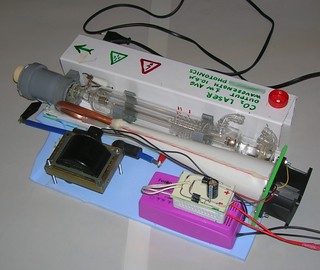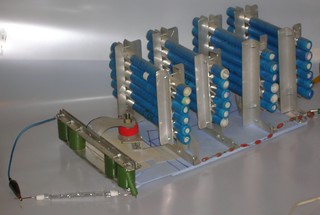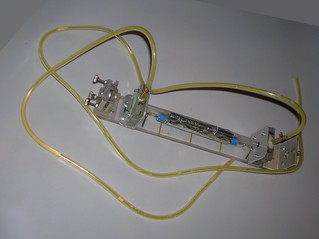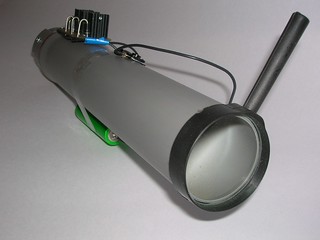 
This photo shows a low-pressure continuous mode CO2 laser built upon industrial 3 W rated
sealed tube. The laser is fed by alternating current from electronic halogen lamp transformer
passed trough an ignition coil. For portability it was necessary to get rid of water cooling.
A very powerful cooler presses the air through that earlier was a water cooling jacket.
As the result the laser does about 1 Watt of output and completely independent of tap water.

Three step Marx bank generator. The capacitors are rolled from
kitchen foil and A4 format mylar (laminating leafs) with 125 mcm
thickness. Charging voltage 12 kv. Output pulse is 3 J x 30 kV x 500 ns.

"Cosmodrome." The Megawatt pulsed RF generator based on a tank circuit.
Intended for feeding lasers by high frequency. Output: 1 J x 10 MHz x 1 mcs.
It was named so for its futuristic outfit. One may see a leyden jar capacitor
with water dielectric. It is charged to 100 kV before the pulse, and oil filled
spark gap, that provides reasonable Q-factor for the circuit without use of
compressed gases. However the oil filled spark gap appeared to be unstable -
the discharge voltage varied by factor of two. This fact has defined the
fortune of the construction - it appeared to be useless... as laser driver.
But as an EMP gun... After it fires, a computer in other room loses
keyboards and mouse. When it is done with a small antenna - it causes alarm
clock of neighbourers to ring chaotically. OTOH now I have a new computer,
multimeter and oscilloscope.

"The Kuzma's mother." (Ultra)fast pulsed transformer rated to 100 kv. The
winding that You see at the picture is the SECONDARY one. In order to improve
efficiency and to avoid the troublesome resonant mode of operation the
ferrite core is used. Output is about 2 J with amplitude ~100 kV in form
of fast decaying oscillations having the period of 2 mcs. Or either (with
matched load) thee is a single pulse with less than 1 mcs duration.
 
The "sailship" Marx bank generator. Uses home rolled capacitors too. 4 steps
72 nf each. Charging voltage is 12 kV. Output is about 20 J at 40 kV in
500 ns pulse. A linear halogen lamp (500W x 220V) lights in a flashlamp mode
i.e. the current flows through plasma and not through incandescent filament.
And then who has said that it is impossible to build a dye laser using a
common halogen lamp?

Still life in the "double martini with soda for droids" style. Two fast
oil filled Tesla coils in the opposite series connection. Spark length is 14 cm.
Length of single spark, do note. In the mode of fast repeating pulses it
may cover about a half of a meter. This device was intended to be used as a
driver of longtitudal CO2 atmospheric pressure laser. However the success
of its creation haven't yet been attemptful.

Dye laser cavity. Not a very suitable to be a guide subject but fully operational. Borosilicate glass tube.
6mm inner diameter, 8 mm - outer diameter. The lamp is 8mm outer diameter, and has 105mm discharge length.
(Bought at electronic goldmine (ty, JS)). Windows are made of uncoated glass. Mirrors are from an old He-Ne laser.

"500 bucks on the table" etude. Dye laser driver. 2-step Marx bank, made of two Maxwells.
It has been built by steps of Jon Singer's work.
Pretty expensive, but works. For the beginning a reliably working sample was needed. However the
spark gaps are home build (air filled), not EG/G type.

Here comes the dye laser spot. Rhodamine G (No, not "6G"!) in isopropanole. Rhodamine is taken
from old supplies, and isopropanol - from a hardware store. Here is 6x10^-5 mol/liter concentration.
As it turns out the key element of the laser is a car fuel filter (You can see it at right bottom
of the picture.) Without it the laser refused to oscillate at all.

Drunk to Green. Fluoresceine generates in... vodka. At about 2e-5mol/l concentration. Laser tube has 4mm diameter. Output mirror - is a piece of He-Ne back mirror (the front one transmits too much). All other is the same as on photos above. Also one can see a plastic cup with the dye solution and an aquarium pump bathing inside it.

Rhodamine in isopropanol got superradiant under lamp pumping! No mirrors at all. Only lamp and capillary with dye. 1e-3 mol/l concentration, 1.5 mm bore diameter. The lamp and driver are the same as on photos above. You can see that laser spot has form of ring. And this ring widens from pulse to pulse.

DIY Laser Pointer based upon a 5W NIR laser diode. Why so big? The larger hole the longer is its usage range and smaller its spot. Output is made with a cheap chinese lense, and the body is sewers plastic tube. Does it burn? Yes it does. Later I will put here some photos or maybe a video.

The same laser pointer. Rear view.
The promised video of this laser pointer in action. This one is a bit upgraded in comparison with the one on the photos above, but uses the same diode. More details on its electronic and optics can be found in this note.


Another open air nitrogennie. Uses the sum of technologies: sharp edged electrodes and rail type spark gap. Dielectric is mylar 0.125 mm thick. Wings are 10 cm wide (each) and 32 cm long. Electrodes are made of aluminium triangle (in section) doorhandles. Their length is 30 cm.
The main intention is to drive test samples with (probably laser) dyes. The thing appears to be pretty powerful. It gives blinding bright spot on a piece of paper and drives rhodamine 6g to lasing at 45 cm away from the end of the electrodes without any focusing optics. The same distance for coumarine reaches above 1 meter. It seems that under its beam anything will lase. There are many photos of this laser in operation, see the report on dye lasers here. Its operational voltage is 13 kV (5 mm spacing in the spark gap)

CO2 laser from a nitrogen one. As one could easily expect it does not work.
|




